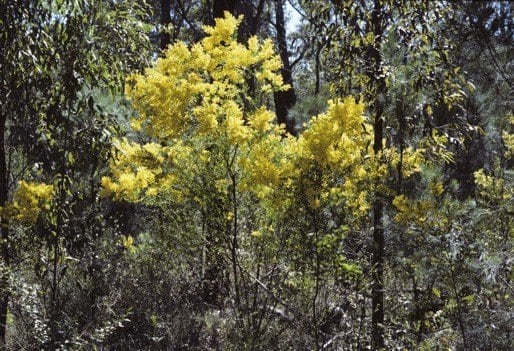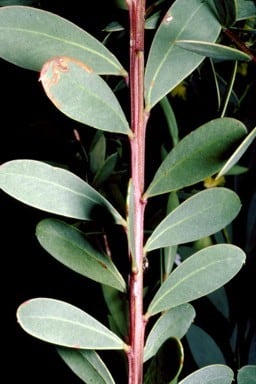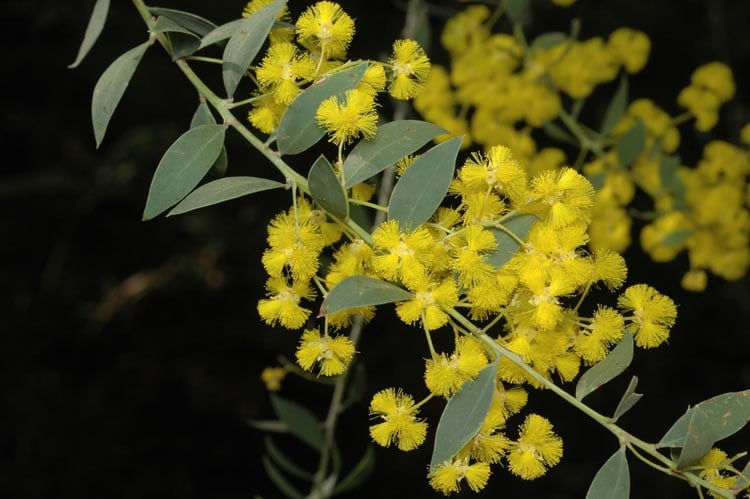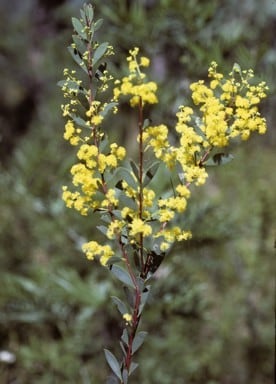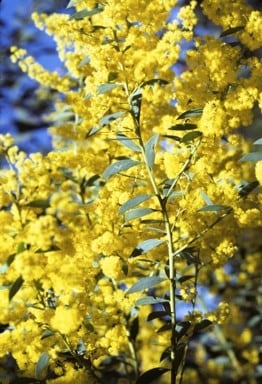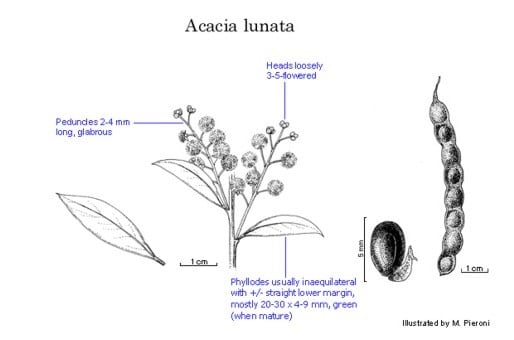Acacia lunata G.Lodd.
WATTLE
Acacias of Australia
Common Name
Lunate-leaved Acacia
Family
Fabaceae
Distribution
Occurs from Putty and Cessnock S to Richmond and Dural, and at Bralga Tops, N.S.W.
Description
Shrub 1–3 m high. Branchlets glabrous. Phyllodes on short stem-projections, usually inequilaterally oblanceolate to narrowly elliptic with the abaxial margin ±straight and adaxial margin curved, (1.5–) 2–3 (–3.5) cm long, (2.5–) 4–9 mm wide, l:w = 3–5, acute to obtuse, excentrically mucronate, thin, green, glaucous to subglaucous when young, glabrous or few marginal hairs near base; midrib not prominent and slightly or obviously towards adaxial margin; lateral nerves obscure; gland not prominent, 2–6 mm above pulvinus. Inflorescences racemose, prolific in upper axils; raceme axes mostly 2–4 cm long, glabrous; peduncles 2–4 mm long, glabrous; heads globular, 5–6 mm diam. at anthesis (fresh), loosely 3–5-flowered, bright golden. Flowers 5-merous; sepals united. Pods narrowly oblong, to 6 cm long, 6–8 mm wide, firmly chartaceous to thinly coriaceous, pruinose especially on convexities over seeds, glabrous. Seeds longitudinal, ovate, 4 mm long, dull, black; aril clavate.
Habitat
Usually grows in sand on sandstone, often on slopes near creeks, in Eucalyptus open forest.
Specimens
N.S.W.: Colo Heights–Upper Colo, 25 Aug. 1959, E.F.Constable s.n. (NSW, PERTH); Cessnock, V.C.Davis 7342/16 (NSW); Dural–Rouse Hill road, 30 Oct. 1956, O.D.Evans (NSW, PERTH); The Putty Rd, 9 km S of the Putty turn-off towards Windsor, B.R.Maslin 5937 (MEXU, NSW, PERTH); Bralga Tops, Glenrock Stn, Upper Barnard R., 4 Sept. 1980, J.C.Turner (NSW).
Notes
The phyllodes of A. lunata are normally similar to those of A. semilunata in being on short stem-projections and inequilaterally oblanceolate to narrowly elliptic with the abaxial margin ±straight and the adaxial margin shallowly convex. However, sometimes a few phyllodes, rarely all of them, have a convex abaxial margin and consequently the marked asymmetry is lost. Specimens with symmetrically oblanceolate or elliptic phyllodes are distinguished from A. leucolobia and A. buxifolia by their 3–5-flowered heads.
Acacia semilunata is recognised especially by its pubescent, terete branchlets (angled towards extremities in A. lunata), 15–20-flowered heads and linear pods 4–5 mm wide.
G.Bentham’s Fl. Austral. 2: 373 (1864) concept of A. lunata included A. leucolobia (syn. A. dealbata A.Cunn., A. brevifolia G.Lodd. & A. oleifolia sens. Benth.), a taxon now regarded as a distinct species. Bentham is followed here in regarding A. falcinella Tausch as conspecific with A. lunata, but without examining the type it is difficult to be sure what this name refers to.
J.H.Maiden, Forest Fl. New South Wales 5: 78–85, pl. 165 (1911), treated A. lunata as conspecific with A. buxifolia (see A. buxifolia for discussion of these two species and A. leucolobia). It should be noted that Maiden’s illustration of the plant he considered to be typical A. lunata contains two significant inaccuracies, namely, the flowers per head are too numerous and the phyllode midribs are shown as centrally situated.
FOA Reference
Data derived from Flora of Australia Volumes 11A (2001), 11B (2001) and 12 (1998), products of ABRS, ©Commonwealth of Australia
Author
Minor edits by B.R.Maslin & J.Rogers
B.R.Maslin
This identification key and fact sheets are available as a mobile application:
URL: https://apps.lucidcentral.org/wattle/
© Copyright 2018. All rights reserved.
